House Renovation Project: Management, Leadership & Skills Project
VerifiedAdded on 2023/06/08
|20
|5911
|416
Project
AI Summary
This assignment provides a comprehensive plan for a house renovation project, covering project scheduling, risk assessment, and leadership and motivation issues. The project management plan includes a Work Breakdown Structure (WBS), network diagram, and a feasibility analysis considering two workers. The risk management section identifies potential risks, analyzes their impact and probability, and suggests appropriate response plans, including risk acceptance, avoidance, mitigation, and transfer strategies. Furthermore, the assignment delves into the motivational challenges of a team member, exploring communication theories to recommend suitable management actions. The report includes a critical path analysis to optimize project timelines and resource allocation, ensuring project completion within the specified timeframe. The document also addresses stakeholder-related risks and technical risks, providing mitigation strategies for each.
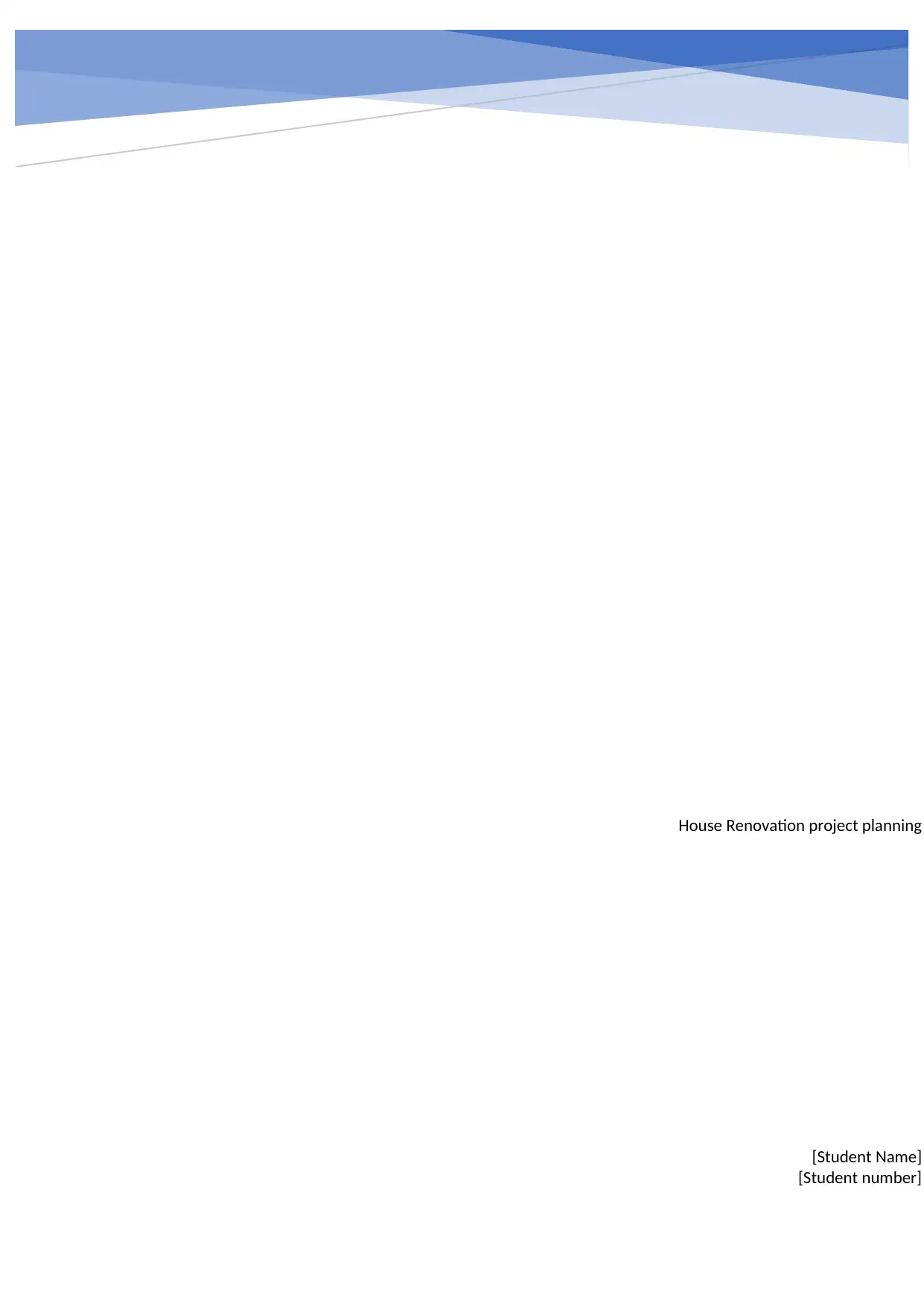
House Renovation project planning
[Student Name]
[Student number]
[Student Name]
[Student number]
Paraphrase This Document
Need a fresh take? Get an instant paraphrase of this document with our AI Paraphraser

1
House Renovation project planning
Table of Contents
Introduction.......................................................................................................................2
PART 1..............................................................................................................................2
WBS.............................................................................................................................................2
Network Diagram........................................................................................................................3
Critical Path Analysis..................................................................................................................3
Project Feasibility with two workers..........................................................................................4
PART 2..............................................................................................................................6
Risk Management........................................................................................................................6
Risk Response Table........................................................................................................................................6
Risk Scores.....................................................................................................................................................10
Opportunities & Strategies.......................................................................................................11
PART 3: Why might Kevin lack motivation?....................................................................15
Conclusion........................................................................................................................17
References.......................................................................................................................17
House Renovation project planning
Table of Contents
Introduction.......................................................................................................................2
PART 1..............................................................................................................................2
WBS.............................................................................................................................................2
Network Diagram........................................................................................................................3
Critical Path Analysis..................................................................................................................3
Project Feasibility with two workers..........................................................................................4
PART 2..............................................................................................................................6
Risk Management........................................................................................................................6
Risk Response Table........................................................................................................................................6
Risk Scores.....................................................................................................................................................10
Opportunities & Strategies.......................................................................................................11
PART 3: Why might Kevin lack motivation?....................................................................15
Conclusion........................................................................................................................17
References.......................................................................................................................17
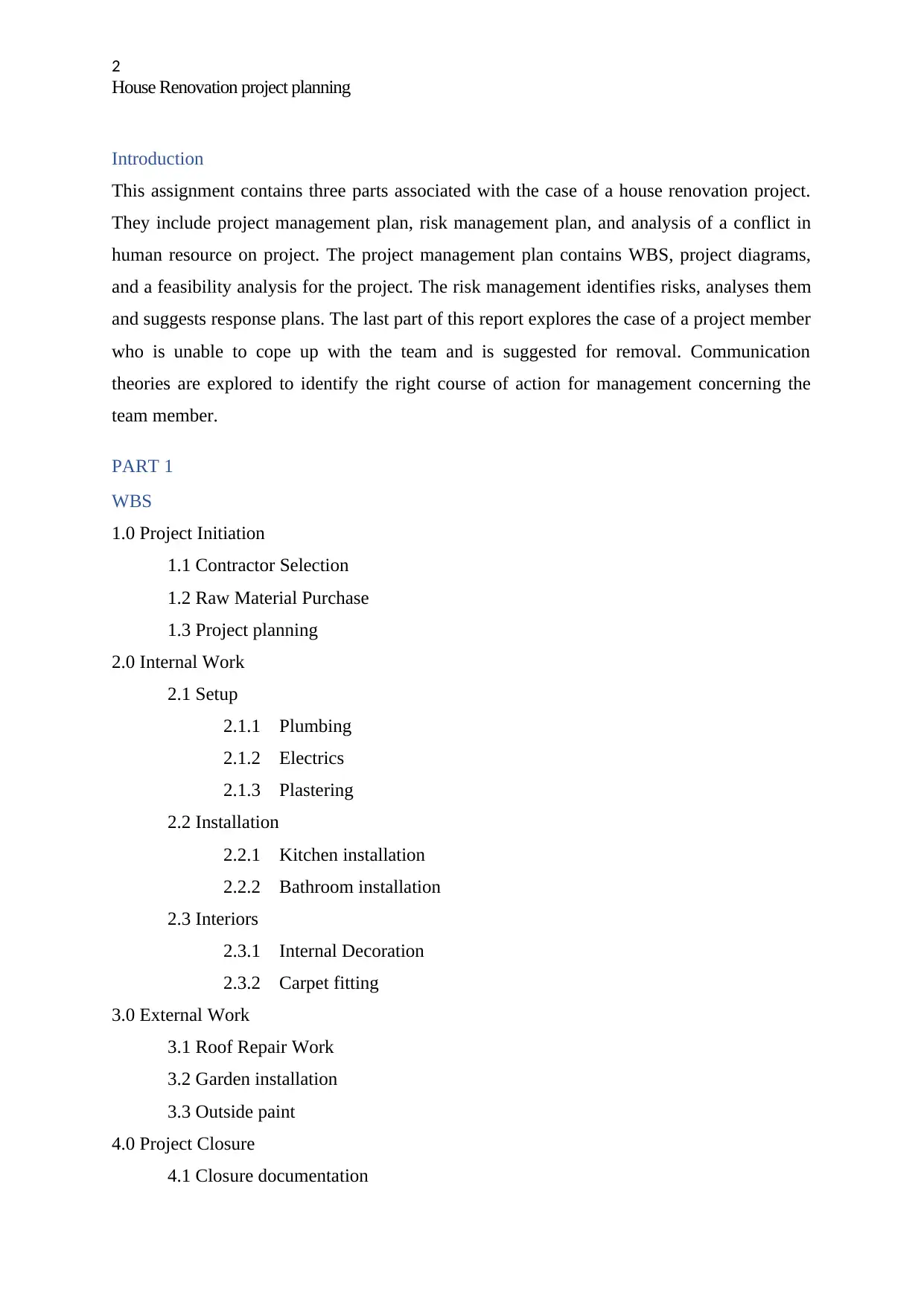
2
House Renovation project planning
Introduction
This assignment contains three parts associated with the case of a house renovation project.
They include project management plan, risk management plan, and analysis of a conflict in
human resource on project. The project management plan contains WBS, project diagrams,
and a feasibility analysis for the project. The risk management identifies risks, analyses them
and suggests response plans. The last part of this report explores the case of a project member
who is unable to cope up with the team and is suggested for removal. Communication
theories are explored to identify the right course of action for management concerning the
team member.
PART 1
WBS
1.0 Project Initiation
1.1 Contractor Selection
1.2 Raw Material Purchase
1.3 Project planning
2.0 Internal Work
2.1 Setup
2.1.1 Plumbing
2.1.2 Electrics
2.1.3 Plastering
2.2 Installation
2.2.1 Kitchen installation
2.2.2 Bathroom installation
2.3 Interiors
2.3.1 Internal Decoration
2.3.2 Carpet fitting
3.0 External Work
3.1 Roof Repair Work
3.2 Garden installation
3.3 Outside paint
4.0 Project Closure
4.1 Closure documentation
House Renovation project planning
Introduction
This assignment contains three parts associated with the case of a house renovation project.
They include project management plan, risk management plan, and analysis of a conflict in
human resource on project. The project management plan contains WBS, project diagrams,
and a feasibility analysis for the project. The risk management identifies risks, analyses them
and suggests response plans. The last part of this report explores the case of a project member
who is unable to cope up with the team and is suggested for removal. Communication
theories are explored to identify the right course of action for management concerning the
team member.
PART 1
WBS
1.0 Project Initiation
1.1 Contractor Selection
1.2 Raw Material Purchase
1.3 Project planning
2.0 Internal Work
2.1 Setup
2.1.1 Plumbing
2.1.2 Electrics
2.1.3 Plastering
2.2 Installation
2.2.1 Kitchen installation
2.2.2 Bathroom installation
2.3 Interiors
2.3.1 Internal Decoration
2.3.2 Carpet fitting
3.0 External Work
3.1 Roof Repair Work
3.2 Garden installation
3.3 Outside paint
4.0 Project Closure
4.1 Closure documentation
⊘ This is a preview!⊘
Do you want full access?
Subscribe today to unlock all pages.

Trusted by 1+ million students worldwide
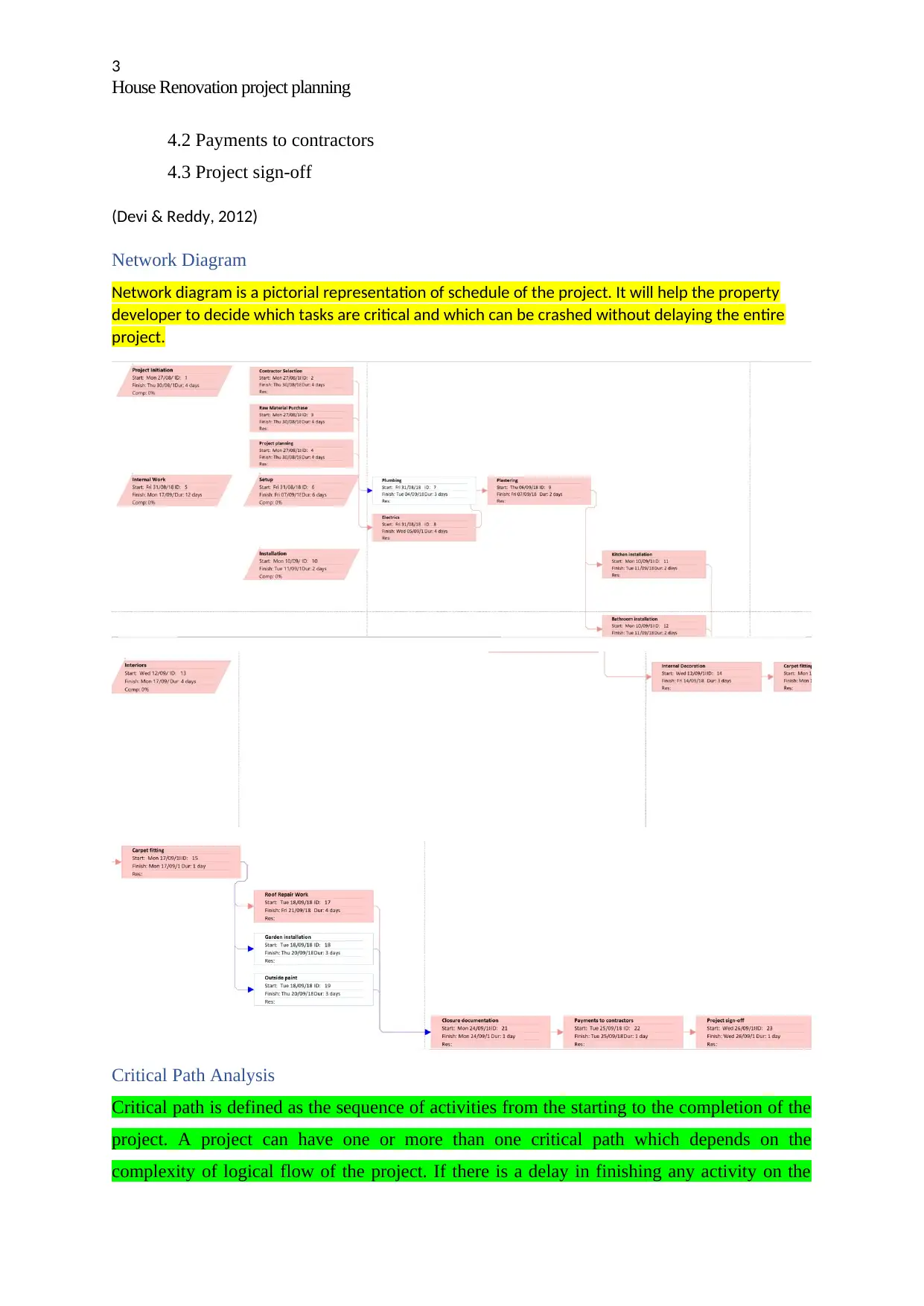
3
House Renovation project planning
4.2 Payments to contractors
4.3 Project sign-off
(Devi & Reddy, 2012)
Network Diagram
Network diagram is a pictorial representation of schedule of the project. It will help the property
developer to decide which tasks are critical and which can be crashed without delaying the entire
project.
Critical Path Analysis
Critical path is defined as the sequence of activities from the starting to the completion of the
project. A project can have one or more than one critical path which depends on the
complexity of logical flow of the project. If there is a delay in finishing any activity on the
House Renovation project planning
4.2 Payments to contractors
4.3 Project sign-off
(Devi & Reddy, 2012)
Network Diagram
Network diagram is a pictorial representation of schedule of the project. It will help the property
developer to decide which tasks are critical and which can be crashed without delaying the entire
project.
Critical Path Analysis
Critical path is defined as the sequence of activities from the starting to the completion of the
project. A project can have one or more than one critical path which depends on the
complexity of logical flow of the project. If there is a delay in finishing any activity on the
Paraphrase This Document
Need a fresh take? Get an instant paraphrase of this document with our AI Paraphraser
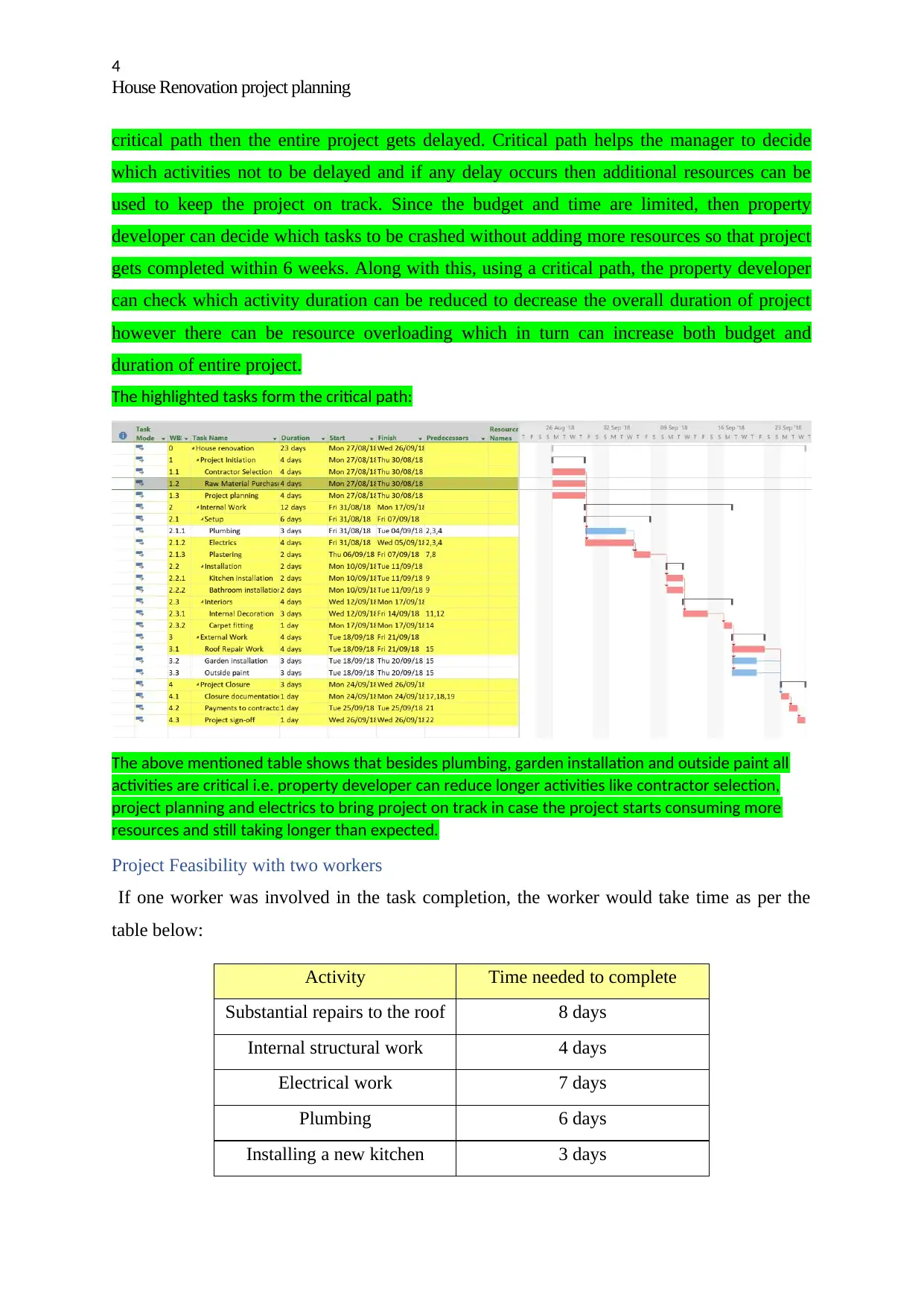
4
House Renovation project planning
critical path then the entire project gets delayed. Critical path helps the manager to decide
which activities not to be delayed and if any delay occurs then additional resources can be
used to keep the project on track. Since the budget and time are limited, then property
developer can decide which tasks to be crashed without adding more resources so that project
gets completed within 6 weeks. Along with this, using a critical path, the property developer
can check which activity duration can be reduced to decrease the overall duration of project
however there can be resource overloading which in turn can increase both budget and
duration of entire project.
The highlighted tasks form the critical path:
The above mentioned table shows that besides plumbing, garden installation and outside paint all
activities are critical i.e. property developer can reduce longer activities like contractor selection,
project planning and electrics to bring project on track in case the project starts consuming more
resources and still taking longer than expected.
Project Feasibility with two workers
If one worker was involved in the task completion, the worker would take time as per the
table below:
Activity Time needed to complete
Substantial repairs to the roof 8 days
Internal structural work 4 days
Electrical work 7 days
Plumbing 6 days
Installing a new kitchen 3 days
House Renovation project planning
critical path then the entire project gets delayed. Critical path helps the manager to decide
which activities not to be delayed and if any delay occurs then additional resources can be
used to keep the project on track. Since the budget and time are limited, then property
developer can decide which tasks to be crashed without adding more resources so that project
gets completed within 6 weeks. Along with this, using a critical path, the property developer
can check which activity duration can be reduced to decrease the overall duration of project
however there can be resource overloading which in turn can increase both budget and
duration of entire project.
The highlighted tasks form the critical path:
The above mentioned table shows that besides plumbing, garden installation and outside paint all
activities are critical i.e. property developer can reduce longer activities like contractor selection,
project planning and electrics to bring project on track in case the project starts consuming more
resources and still taking longer than expected.
Project Feasibility with two workers
If one worker was involved in the task completion, the worker would take time as per the
table below:
Activity Time needed to complete
Substantial repairs to the roof 8 days
Internal structural work 4 days
Electrical work 7 days
Plumbing 6 days
Installing a new kitchen 3 days
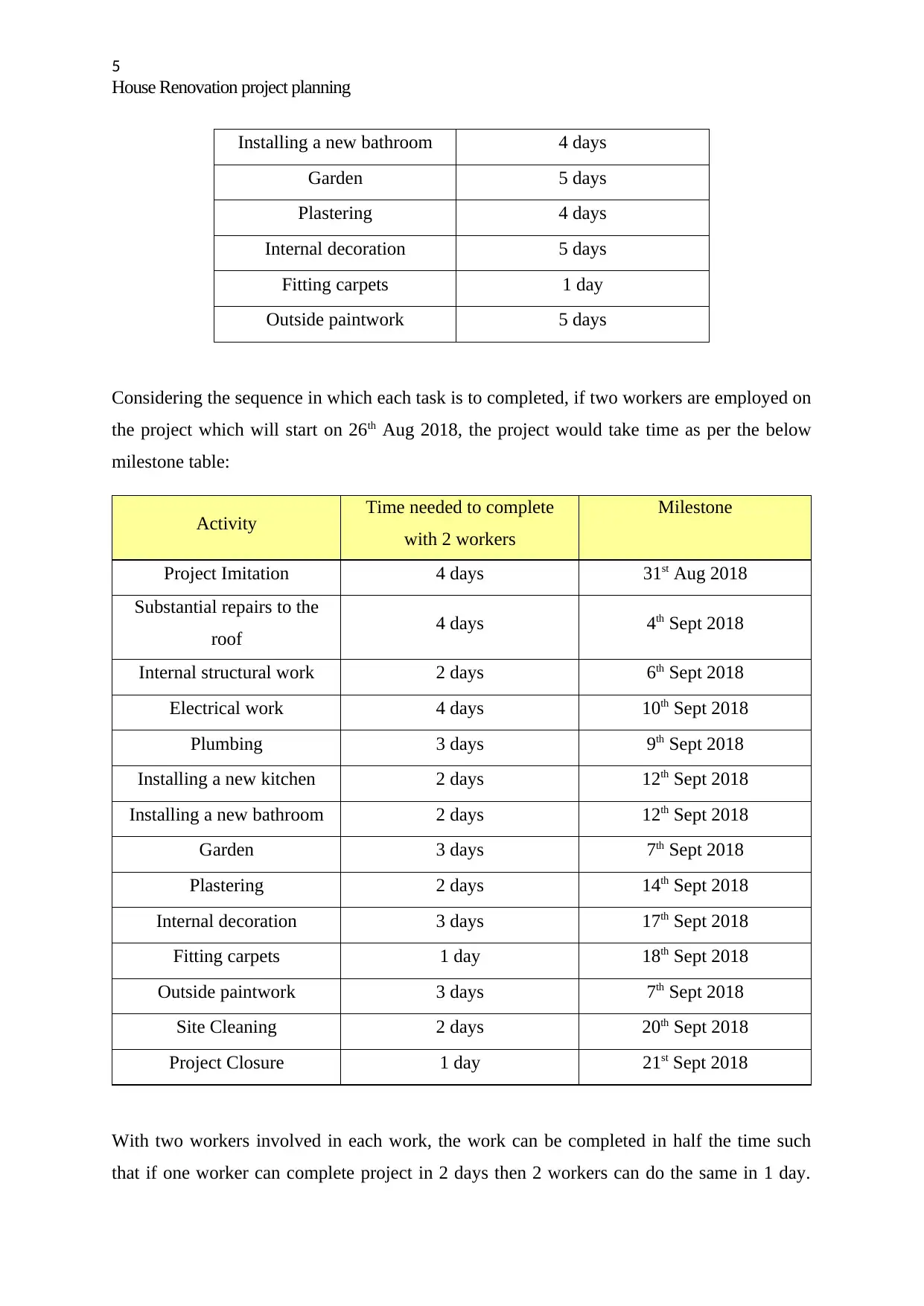
5
House Renovation project planning
Installing a new bathroom 4 days
Garden 5 days
Plastering 4 days
Internal decoration 5 days
Fitting carpets 1 day
Outside paintwork 5 days
Considering the sequence in which each task is to completed, if two workers are employed on
the project which will start on 26th Aug 2018, the project would take time as per the below
milestone table:
Activity Time needed to complete
with 2 workers
Milestone
Project Imitation 4 days 31st Aug 2018
Substantial repairs to the
roof 4 days 4th Sept 2018
Internal structural work 2 days 6th Sept 2018
Electrical work 4 days 10th Sept 2018
Plumbing 3 days 9th Sept 2018
Installing a new kitchen 2 days 12th Sept 2018
Installing a new bathroom 2 days 12th Sept 2018
Garden 3 days 7th Sept 2018
Plastering 2 days 14th Sept 2018
Internal decoration 3 days 17th Sept 2018
Fitting carpets 1 day 18th Sept 2018
Outside paintwork 3 days 7th Sept 2018
Site Cleaning 2 days 20th Sept 2018
Project Closure 1 day 21st Sept 2018
With two workers involved in each work, the work can be completed in half the time such
that if one worker can complete project in 2 days then 2 workers can do the same in 1 day.
House Renovation project planning
Installing a new bathroom 4 days
Garden 5 days
Plastering 4 days
Internal decoration 5 days
Fitting carpets 1 day
Outside paintwork 5 days
Considering the sequence in which each task is to completed, if two workers are employed on
the project which will start on 26th Aug 2018, the project would take time as per the below
milestone table:
Activity Time needed to complete
with 2 workers
Milestone
Project Imitation 4 days 31st Aug 2018
Substantial repairs to the
roof 4 days 4th Sept 2018
Internal structural work 2 days 6th Sept 2018
Electrical work 4 days 10th Sept 2018
Plumbing 3 days 9th Sept 2018
Installing a new kitchen 2 days 12th Sept 2018
Installing a new bathroom 2 days 12th Sept 2018
Garden 3 days 7th Sept 2018
Plastering 2 days 14th Sept 2018
Internal decoration 3 days 17th Sept 2018
Fitting carpets 1 day 18th Sept 2018
Outside paintwork 3 days 7th Sept 2018
Site Cleaning 2 days 20th Sept 2018
Project Closure 1 day 21st Sept 2018
With two workers involved in each work, the work can be completed in half the time such
that if one worker can complete project in 2 days then 2 workers can do the same in 1 day.
⊘ This is a preview!⊘
Do you want full access?
Subscribe today to unlock all pages.

Trusted by 1+ million students worldwide
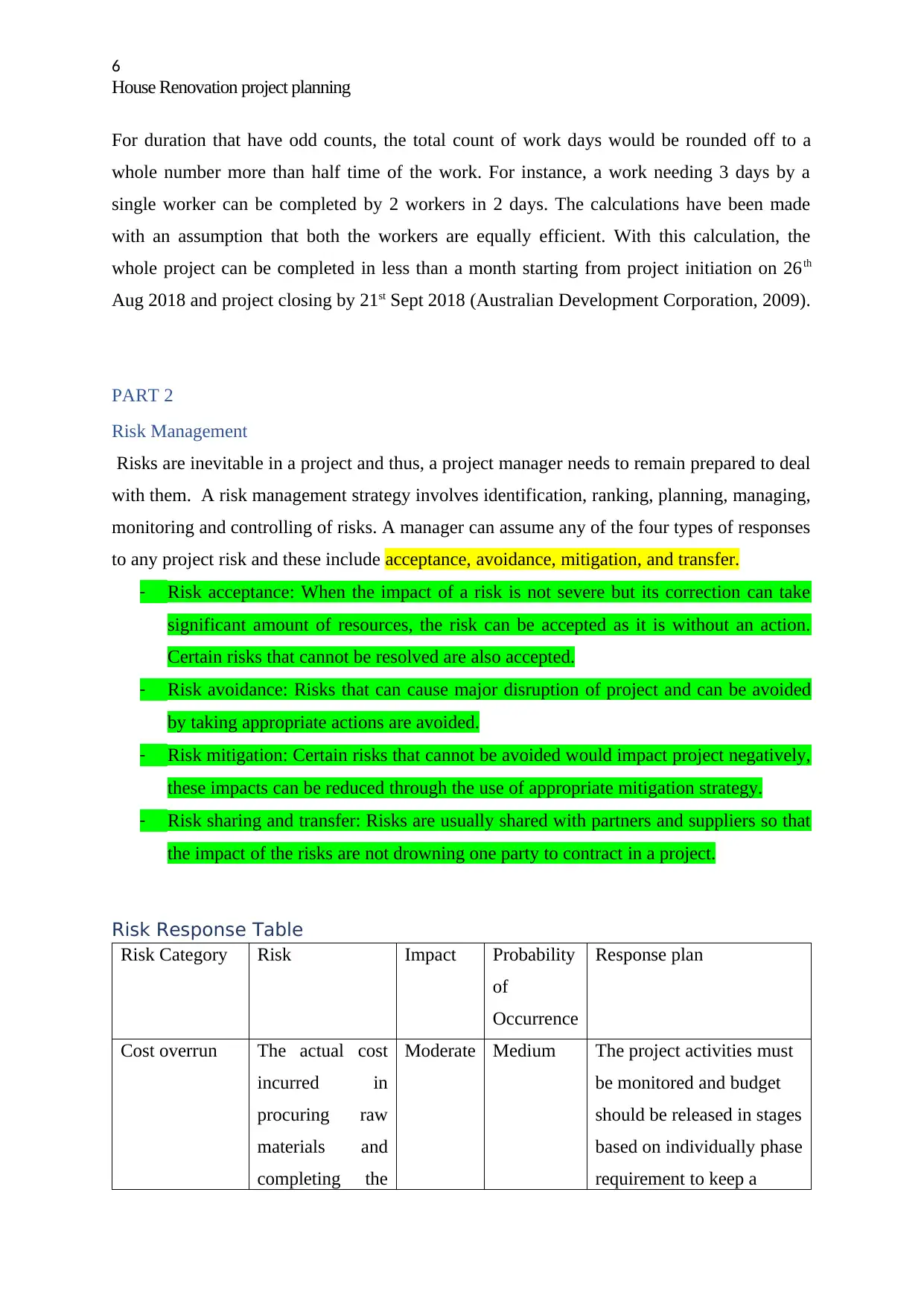
6
House Renovation project planning
For duration that have odd counts, the total count of work days would be rounded off to a
whole number more than half time of the work. For instance, a work needing 3 days by a
single worker can be completed by 2 workers in 2 days. The calculations have been made
with an assumption that both the workers are equally efficient. With this calculation, the
whole project can be completed in less than a month starting from project initiation on 26th
Aug 2018 and project closing by 21st Sept 2018 (Australian Development Corporation, 2009).
PART 2
Risk Management
Risks are inevitable in a project and thus, a project manager needs to remain prepared to deal
with them. A risk management strategy involves identification, ranking, planning, managing,
monitoring and controlling of risks. A manager can assume any of the four types of responses
to any project risk and these include acceptance, avoidance, mitigation, and transfer.
- Risk acceptance: When the impact of a risk is not severe but its correction can take
significant amount of resources, the risk can be accepted as it is without an action.
Certain risks that cannot be resolved are also accepted.
- Risk avoidance: Risks that can cause major disruption of project and can be avoided
by taking appropriate actions are avoided.
- Risk mitigation: Certain risks that cannot be avoided would impact project negatively,
these impacts can be reduced through the use of appropriate mitigation strategy.
- Risk sharing and transfer: Risks are usually shared with partners and suppliers so that
the impact of the risks are not drowning one party to contract in a project.
Risk Response Table
Risk Category Risk Impact Probability
of
Occurrence
Response plan
Cost overrun The actual cost
incurred in
procuring raw
materials and
completing the
Moderate Medium The project activities must
be monitored and budget
should be released in stages
based on individually phase
requirement to keep a
House Renovation project planning
For duration that have odd counts, the total count of work days would be rounded off to a
whole number more than half time of the work. For instance, a work needing 3 days by a
single worker can be completed by 2 workers in 2 days. The calculations have been made
with an assumption that both the workers are equally efficient. With this calculation, the
whole project can be completed in less than a month starting from project initiation on 26th
Aug 2018 and project closing by 21st Sept 2018 (Australian Development Corporation, 2009).
PART 2
Risk Management
Risks are inevitable in a project and thus, a project manager needs to remain prepared to deal
with them. A risk management strategy involves identification, ranking, planning, managing,
monitoring and controlling of risks. A manager can assume any of the four types of responses
to any project risk and these include acceptance, avoidance, mitigation, and transfer.
- Risk acceptance: When the impact of a risk is not severe but its correction can take
significant amount of resources, the risk can be accepted as it is without an action.
Certain risks that cannot be resolved are also accepted.
- Risk avoidance: Risks that can cause major disruption of project and can be avoided
by taking appropriate actions are avoided.
- Risk mitigation: Certain risks that cannot be avoided would impact project negatively,
these impacts can be reduced through the use of appropriate mitigation strategy.
- Risk sharing and transfer: Risks are usually shared with partners and suppliers so that
the impact of the risks are not drowning one party to contract in a project.
Risk Response Table
Risk Category Risk Impact Probability
of
Occurrence
Response plan
Cost overrun The actual cost
incurred in
procuring raw
materials and
completing the
Moderate Medium The project activities must
be monitored and budget
should be released in stages
based on individually phase
requirement to keep a
Paraphrase This Document
Need a fresh take? Get an instant paraphrase of this document with our AI Paraphraser

7
House Renovation project planning
renovation work
can take more
expenses than
initially planned
(SAEO, 2015).
control over the costs of the
project.
The budget should be
allotted as per the
requirements of each
activity identified in the
WBS and a contingency
amount should be added to
the total budget at the time
of approval so that any
variations from expected in
investments can be taken
care of (C.R & Thomas,
2011).
Scheduling
risks
Delays are
caused in
delivers of the
project tasks
such as supplier
delays in sending
raw materials or
delays in the
plumbing,
electric or repair
work by the
assigned workers
(Smith, 2014)
Moderate High The project must be
monitored according to the
schedule of the project and
at any hint of getting
delays, appropriate actions
must be taken immediately
to ensure that work gets
completed on time. If
delays are still occurring,
the project manager may
have to use additional
resources to keep up with
the work. For delays that
cannot be prevented and
can cause delays in final
delivery of the project,
additional approval may be
taken for extension of the
project schedule from the
House Renovation project planning
renovation work
can take more
expenses than
initially planned
(SAEO, 2015).
control over the costs of the
project.
The budget should be
allotted as per the
requirements of each
activity identified in the
WBS and a contingency
amount should be added to
the total budget at the time
of approval so that any
variations from expected in
investments can be taken
care of (C.R & Thomas,
2011).
Scheduling
risks
Delays are
caused in
delivers of the
project tasks
such as supplier
delays in sending
raw materials or
delays in the
plumbing,
electric or repair
work by the
assigned workers
(Smith, 2014)
Moderate High The project must be
monitored according to the
schedule of the project and
at any hint of getting
delays, appropriate actions
must be taken immediately
to ensure that work gets
completed on time. If
delays are still occurring,
the project manager may
have to use additional
resources to keep up with
the work. For delays that
cannot be prevented and
can cause delays in final
delivery of the project,
additional approval may be
taken for extension of the
project schedule from the
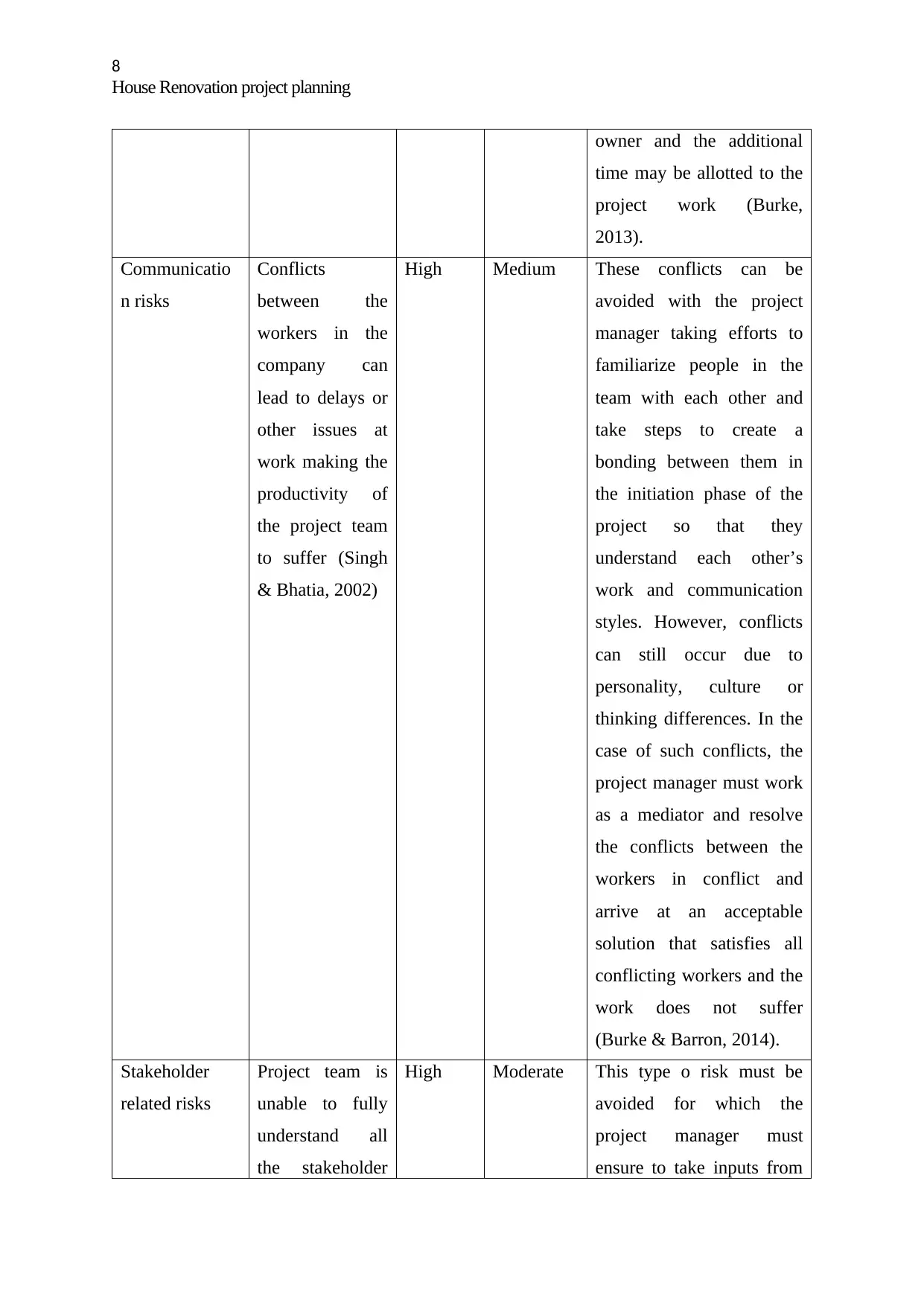
8
House Renovation project planning
owner and the additional
time may be allotted to the
project work (Burke,
2013).
Communicatio
n risks
Conflicts
between the
workers in the
company can
lead to delays or
other issues at
work making the
productivity of
the project team
to suffer (Singh
& Bhatia, 2002)
High Medium These conflicts can be
avoided with the project
manager taking efforts to
familiarize people in the
team with each other and
take steps to create a
bonding between them in
the initiation phase of the
project so that they
understand each other’s
work and communication
styles. However, conflicts
can still occur due to
personality, culture or
thinking differences. In the
case of such conflicts, the
project manager must work
as a mediator and resolve
the conflicts between the
workers in conflict and
arrive at an acceptable
solution that satisfies all
conflicting workers and the
work does not suffer
(Burke & Barron, 2014).
Stakeholder
related risks
Project team is
unable to fully
understand all
the stakeholder
High Moderate This type o risk must be
avoided for which the
project manager must
ensure to take inputs from
House Renovation project planning
owner and the additional
time may be allotted to the
project work (Burke,
2013).
Communicatio
n risks
Conflicts
between the
workers in the
company can
lead to delays or
other issues at
work making the
productivity of
the project team
to suffer (Singh
& Bhatia, 2002)
High Medium These conflicts can be
avoided with the project
manager taking efforts to
familiarize people in the
team with each other and
take steps to create a
bonding between them in
the initiation phase of the
project so that they
understand each other’s
work and communication
styles. However, conflicts
can still occur due to
personality, culture or
thinking differences. In the
case of such conflicts, the
project manager must work
as a mediator and resolve
the conflicts between the
workers in conflict and
arrive at an acceptable
solution that satisfies all
conflicting workers and the
work does not suffer
(Burke & Barron, 2014).
Stakeholder
related risks
Project team is
unable to fully
understand all
the stakeholder
High Moderate This type o risk must be
avoided for which the
project manager must
ensure to take inputs from
⊘ This is a preview!⊘
Do you want full access?
Subscribe today to unlock all pages.

Trusted by 1+ million students worldwide
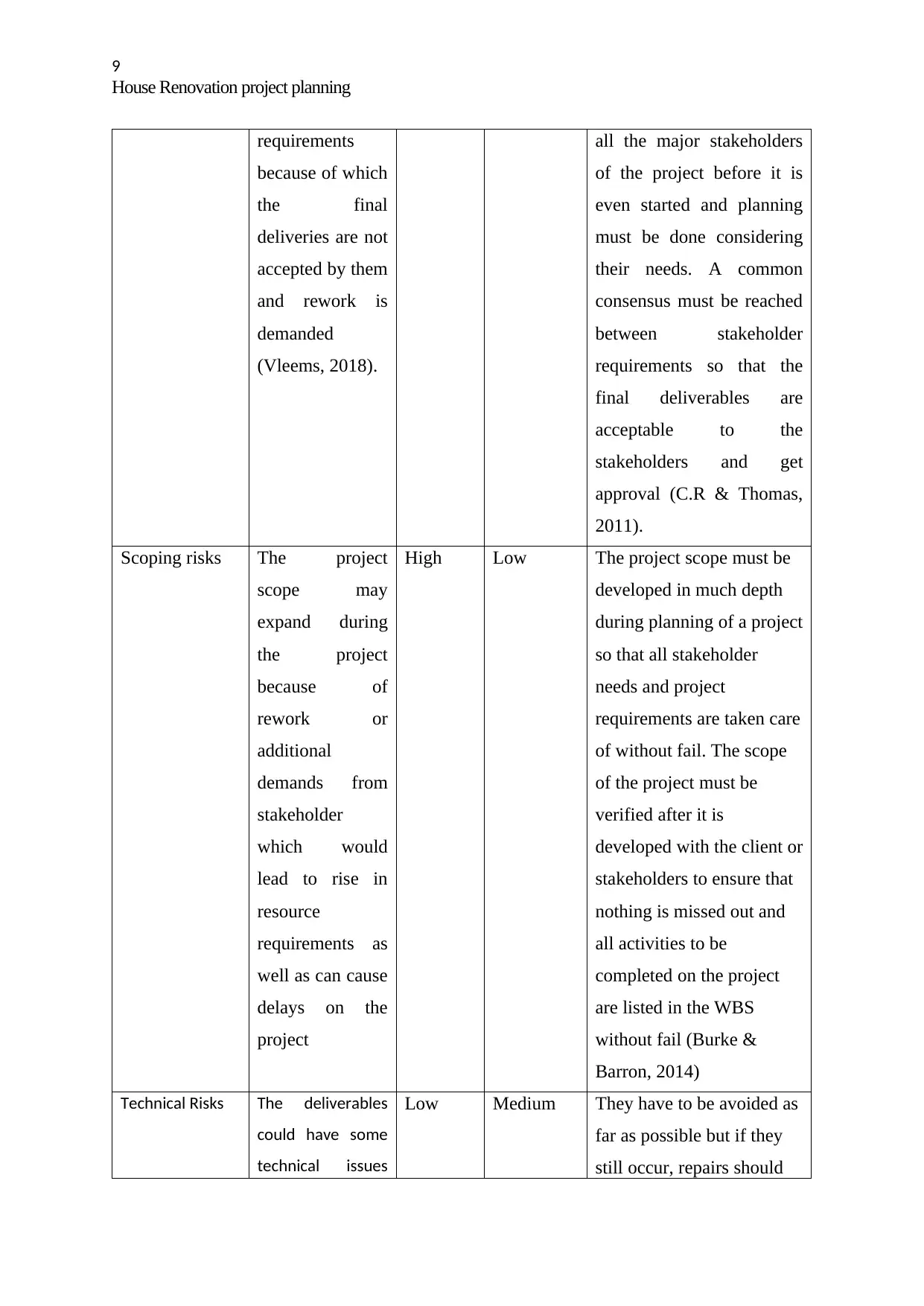
9
House Renovation project planning
requirements
because of which
the final
deliveries are not
accepted by them
and rework is
demanded
(Vleems, 2018).
all the major stakeholders
of the project before it is
even started and planning
must be done considering
their needs. A common
consensus must be reached
between stakeholder
requirements so that the
final deliverables are
acceptable to the
stakeholders and get
approval (C.R & Thomas,
2011).
Scoping risks The project
scope may
expand during
the project
because of
rework or
additional
demands from
stakeholder
which would
lead to rise in
resource
requirements as
well as can cause
delays on the
project
High Low The project scope must be
developed in much depth
during planning of a project
so that all stakeholder
needs and project
requirements are taken care
of without fail. The scope
of the project must be
verified after it is
developed with the client or
stakeholders to ensure that
nothing is missed out and
all activities to be
completed on the project
are listed in the WBS
without fail (Burke &
Barron, 2014)
Technical Risks The deliverables
could have some
technical issues
Low Medium They have to be avoided as
far as possible but if they
still occur, repairs should
House Renovation project planning
requirements
because of which
the final
deliveries are not
accepted by them
and rework is
demanded
(Vleems, 2018).
all the major stakeholders
of the project before it is
even started and planning
must be done considering
their needs. A common
consensus must be reached
between stakeholder
requirements so that the
final deliverables are
acceptable to the
stakeholders and get
approval (C.R & Thomas,
2011).
Scoping risks The project
scope may
expand during
the project
because of
rework or
additional
demands from
stakeholder
which would
lead to rise in
resource
requirements as
well as can cause
delays on the
project
High Low The project scope must be
developed in much depth
during planning of a project
so that all stakeholder
needs and project
requirements are taken care
of without fail. The scope
of the project must be
verified after it is
developed with the client or
stakeholders to ensure that
nothing is missed out and
all activities to be
completed on the project
are listed in the WBS
without fail (Burke &
Barron, 2014)
Technical Risks The deliverables
could have some
technical issues
Low Medium They have to be avoided as
far as possible but if they
still occur, repairs should
Paraphrase This Document
Need a fresh take? Get an instant paraphrase of this document with our AI Paraphraser
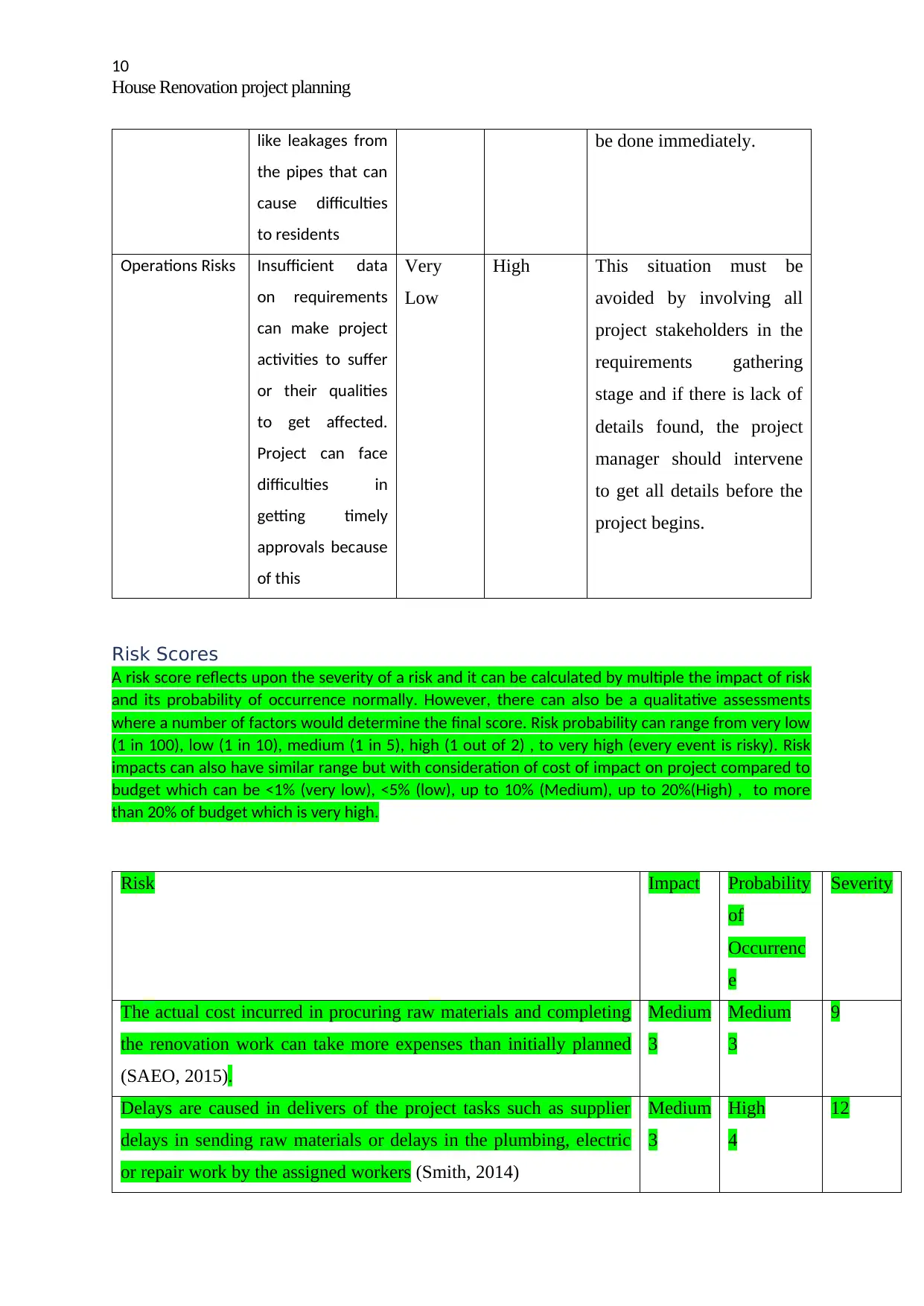
10
House Renovation project planning
like leakages from
the pipes that can
cause difficulties
to residents
be done immediately.
Operations Risks Insufficient data
on requirements
can make project
activities to suffer
or their qualities
to get affected.
Project can face
difficulties in
getting timely
approvals because
of this
Very
Low
High This situation must be
avoided by involving all
project stakeholders in the
requirements gathering
stage and if there is lack of
details found, the project
manager should intervene
to get all details before the
project begins.
Risk Scores
A risk score reflects upon the severity of a risk and it can be calculated by multiple the impact of risk
and its probability of occurrence normally. However, there can also be a qualitative assessments
where a number of factors would determine the final score. Risk probability can range from very low
(1 in 100), low (1 in 10), medium (1 in 5), high (1 out of 2) , to very high (every event is risky). Risk
impacts can also have similar range but with consideration of cost of impact on project compared to
budget which can be <1% (very low), <5% (low), up to 10% (Medium), up to 20%(High) , to more
than 20% of budget which is very high.
Risk Impact Probability
of
Occurrenc
e
Severity
The actual cost incurred in procuring raw materials and completing
the renovation work can take more expenses than initially planned
(SAEO, 2015).
Medium
3
Medium
3
9
Delays are caused in delivers of the project tasks such as supplier
delays in sending raw materials or delays in the plumbing, electric
or repair work by the assigned workers (Smith, 2014)
Medium
3
High
4
12
House Renovation project planning
like leakages from
the pipes that can
cause difficulties
to residents
be done immediately.
Operations Risks Insufficient data
on requirements
can make project
activities to suffer
or their qualities
to get affected.
Project can face
difficulties in
getting timely
approvals because
of this
Very
Low
High This situation must be
avoided by involving all
project stakeholders in the
requirements gathering
stage and if there is lack of
details found, the project
manager should intervene
to get all details before the
project begins.
Risk Scores
A risk score reflects upon the severity of a risk and it can be calculated by multiple the impact of risk
and its probability of occurrence normally. However, there can also be a qualitative assessments
where a number of factors would determine the final score. Risk probability can range from very low
(1 in 100), low (1 in 10), medium (1 in 5), high (1 out of 2) , to very high (every event is risky). Risk
impacts can also have similar range but with consideration of cost of impact on project compared to
budget which can be <1% (very low), <5% (low), up to 10% (Medium), up to 20%(High) , to more
than 20% of budget which is very high.
Risk Impact Probability
of
Occurrenc
e
Severity
The actual cost incurred in procuring raw materials and completing
the renovation work can take more expenses than initially planned
(SAEO, 2015).
Medium
3
Medium
3
9
Delays are caused in delivers of the project tasks such as supplier
delays in sending raw materials or delays in the plumbing, electric
or repair work by the assigned workers (Smith, 2014)
Medium
3
High
4
12
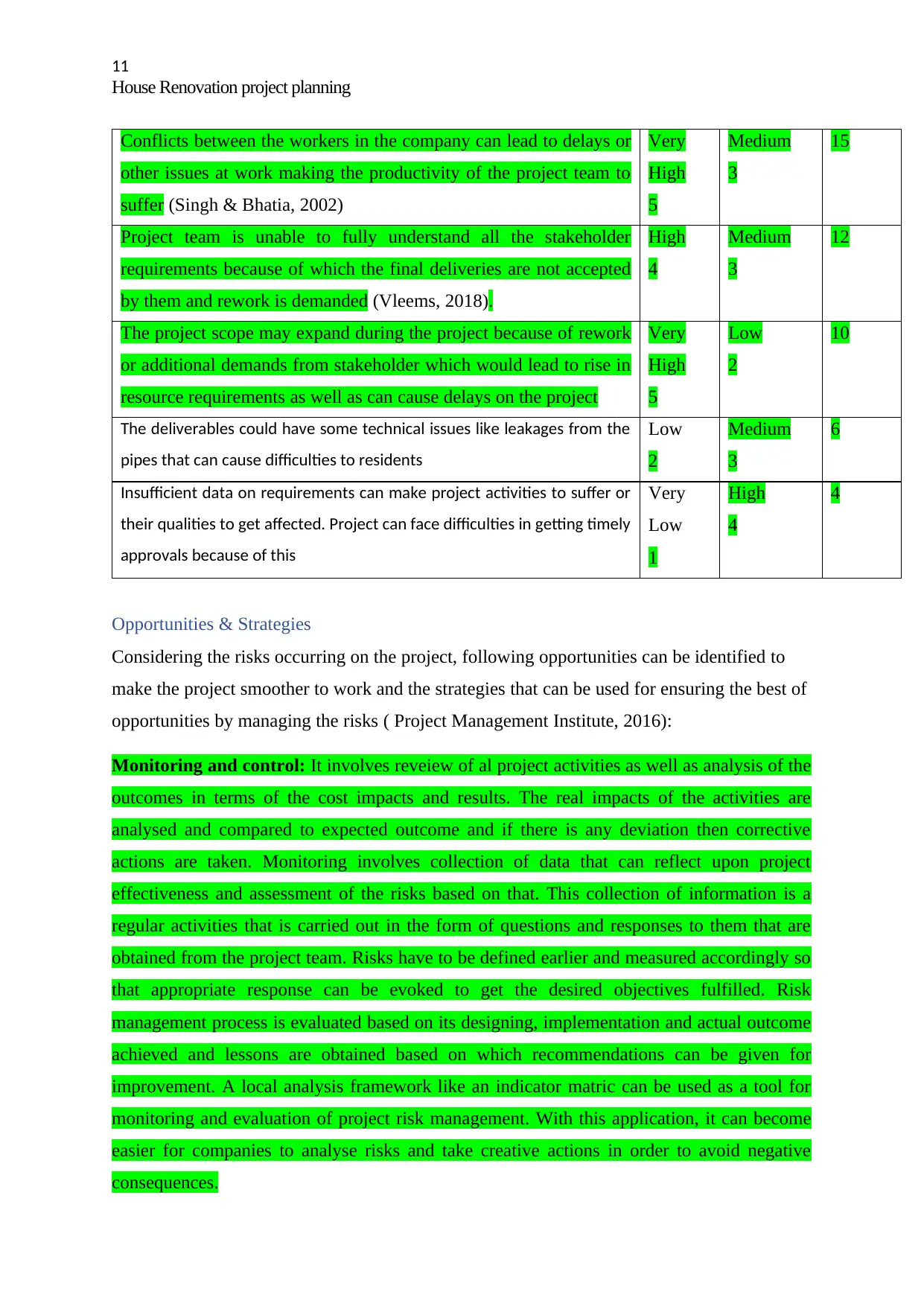
11
House Renovation project planning
Conflicts between the workers in the company can lead to delays or
other issues at work making the productivity of the project team to
suffer (Singh & Bhatia, 2002)
Very
High
5
Medium
3
15
Project team is unable to fully understand all the stakeholder
requirements because of which the final deliveries are not accepted
by them and rework is demanded (Vleems, 2018).
High
4
Medium
3
12
The project scope may expand during the project because of rework
or additional demands from stakeholder which would lead to rise in
resource requirements as well as can cause delays on the project
Very
High
5
Low
2
10
The deliverables could have some technical issues like leakages from the
pipes that can cause difficulties to residents
Low
2
Medium
3
6
Insufficient data on requirements can make project activities to suffer or
their qualities to get affected. Project can face difficulties in getting timely
approvals because of this
Very
Low
1
High
4
4
Opportunities & Strategies
Considering the risks occurring on the project, following opportunities can be identified to
make the project smoother to work and the strategies that can be used for ensuring the best of
opportunities by managing the risks ( Project Management Institute, 2016):
Monitoring and control: It involves reveiew of al project activities as well as analysis of the
outcomes in terms of the cost impacts and results. The real impacts of the activities are
analysed and compared to expected outcome and if there is any deviation then corrective
actions are taken. Monitoring involves collection of data that can reflect upon project
effectiveness and assessment of the risks based on that. This collection of information is a
regular activities that is carried out in the form of questions and responses to them that are
obtained from the project team. Risks have to be defined earlier and measured accordingly so
that appropriate response can be evoked to get the desired objectives fulfilled. Risk
management process is evaluated based on its designing, implementation and actual outcome
achieved and lessons are obtained based on which recommendations can be given for
improvement. A local analysis framework like an indicator matric can be used as a tool for
monitoring and evaluation of project risk management. With this application, it can become
easier for companies to analyse risks and take creative actions in order to avoid negative
consequences.
House Renovation project planning
Conflicts between the workers in the company can lead to delays or
other issues at work making the productivity of the project team to
suffer (Singh & Bhatia, 2002)
Very
High
5
Medium
3
15
Project team is unable to fully understand all the stakeholder
requirements because of which the final deliveries are not accepted
by them and rework is demanded (Vleems, 2018).
High
4
Medium
3
12
The project scope may expand during the project because of rework
or additional demands from stakeholder which would lead to rise in
resource requirements as well as can cause delays on the project
Very
High
5
Low
2
10
The deliverables could have some technical issues like leakages from the
pipes that can cause difficulties to residents
Low
2
Medium
3
6
Insufficient data on requirements can make project activities to suffer or
their qualities to get affected. Project can face difficulties in getting timely
approvals because of this
Very
Low
1
High
4
4
Opportunities & Strategies
Considering the risks occurring on the project, following opportunities can be identified to
make the project smoother to work and the strategies that can be used for ensuring the best of
opportunities by managing the risks ( Project Management Institute, 2016):
Monitoring and control: It involves reveiew of al project activities as well as analysis of the
outcomes in terms of the cost impacts and results. The real impacts of the activities are
analysed and compared to expected outcome and if there is any deviation then corrective
actions are taken. Monitoring involves collection of data that can reflect upon project
effectiveness and assessment of the risks based on that. This collection of information is a
regular activities that is carried out in the form of questions and responses to them that are
obtained from the project team. Risks have to be defined earlier and measured accordingly so
that appropriate response can be evoked to get the desired objectives fulfilled. Risk
management process is evaluated based on its designing, implementation and actual outcome
achieved and lessons are obtained based on which recommendations can be given for
improvement. A local analysis framework like an indicator matric can be used as a tool for
monitoring and evaluation of project risk management. With this application, it can become
easier for companies to analyse risks and take creative actions in order to avoid negative
consequences.
⊘ This is a preview!⊘
Do you want full access?
Subscribe today to unlock all pages.

Trusted by 1+ million students worldwide
1 out of 20
Related Documents
Your All-in-One AI-Powered Toolkit for Academic Success.
+13062052269
info@desklib.com
Available 24*7 on WhatsApp / Email
![[object Object]](/_next/static/media/star-bottom.7253800d.svg)
Unlock your academic potential
Copyright © 2020–2026 A2Z Services. All Rights Reserved. Developed and managed by ZUCOL.





